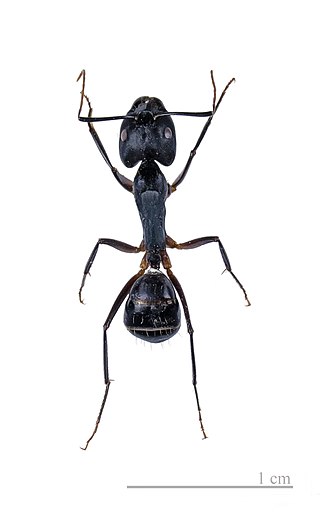
The Formicinae are a subfamily within the Formicidae containing ants of moderate evolutionary development.

Myrmicinae is a subfamily of ants, with about 140 extant genera; their distribution is cosmopolitan. The pupae lack cocoons. Some species retain a functional sting. The petioles of Myrmicinae consist of two nodes. The nests are permanent and in soil, rotting wood, under stones, or in trees.
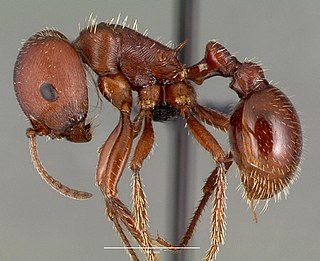
Pogonomyrmex is a genus of harvester ants, occurring primarily in the deserts of North, Central, and South America, with a single endemic species from Haiti.
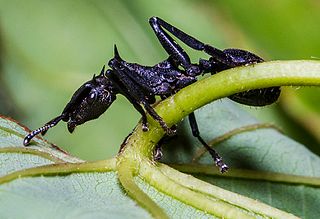
Cephalotes is a genus of tree-dwelling ant species from the Americas, commonly known as turtle ants. All appear to be gliding ants, with the ability to "parachute" and steer their fall so as to land back on the tree trunk rather than fall to the ground, which is often flooded.

Crematogaster is an ecologically diverse genus of ants found worldwide, which are characterised by a distinctive heart-shaped gaster (abdomen), which gives them one of their common names, the Saint Valentine ant. Members of this genus are also known as cocktail ants because of their habit of raising their abdomens when alarmed. Most species are arboreal (tree-dwelling). These ants are sometimes known as acrobat ants.

Megalomyrmex is a genus of ant in the subfamily Myrmicinae. The genus is known only from the Neotropics, where some of the species are specialized parasites or predators of Attini.
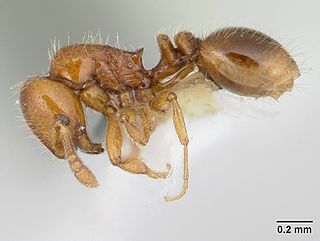
Oxyepoecus is a Neotropical genus of ant in the subfamily Myrmicinae. The genus is a member of the tribe Solenopsidini and currently includes 20 species.

Pseudomyrmex is a genus of stinging, wasp-like ants in the subfamily Pseudomyrmecinae. They are large-eyed, slender ants, found mainly in tropical and subtropical regions of the New World.

Pachycondyla is a ponerine genus of ants found in the Neotropics.

Anochetus is a genus of small, carnivorous ants found in the tropics and subtropics throughout the world.

Dolichoderus is a genus of ants found worldwide.

Cyphomyrmex is a genus of fungus-growing ants found primarily in South and Central America. However, some species do come up to the southern portion of North America. They grow a variety of fungi in the tribe Leucocoprineae. Most fungal gardens are grown in small nodules, some species to cultivate entire mycelium, though. Colonies are monogynous and are relatively small with about 100 workers on average.
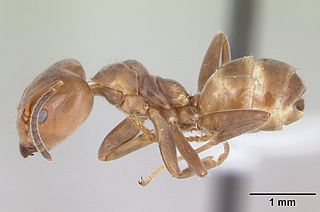
Azteca is a strictly Neotropical genus of ants in the subfamily Dolichoderinae. The genus is very diverse and contains around 84 extant species and two fossil species. They are essentially arboreal and many species have mutualistic associations with particular plant species, where the genus Cecropia presents the most conspicuous association. In the Brazilian Amazonia, Azteca species are associated with species of Codonanthopsis.
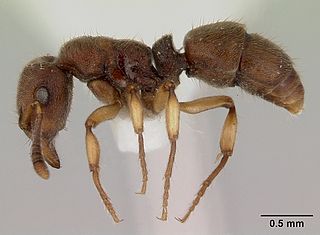
Heteroponera is a genus of ants in the subfamily Ectatomminae. The genus is known from the Neotropics and Australasia.

Neivamyrmex is a genus of army ants in the subfamily Dorylinae.

Octostruma is a genus of ants in the subfamily Myrmicinae. The genus is found in the Neotropics.

Nesomyrmex is a genus of ants in the subfamily Myrmicinae. The genus is distributed in the Neotropical, Afrotropical and Malagasy regions. Most species live in arid climates, but some are known from the rainforest. They nest in soil or in trees. Little is known about their biology.

Myrmelachista is a Neotropical genus of ants in the subfamily Formicinae. The genus is found exclusively in the Neotropical realm. Little is known regarding their biology.


















